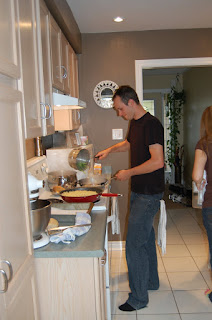Trim off as much silver skin and unnecessary fat as you can, portion the shoulder into manageable sizes (4 x 3lbs).
Shoulder of Venison is ridiculously tough, with intertwining amounts of silver skin flowing everywhere. Do your best to remove what you can while keeping the dignity of the meat. Your boning knife should be razor sharp for this.

The Mise En Place; Mirepoix, Separate Aromatics (Black Pepper Corns, Garlic, Thyme, Rosemary, Parsely Stems, Bay Leaf), 1.5 Cups Brandy, 4 lt. BEAUTIFUL Veal Stock, Portioned Venison Shoulder

1) Use Kosher Salt, generously completely season the meat on all sides. On high heat, brown the meat, let cool completely on a rack in a fridge.

2) Using a rondeau with a splash of olive oil on high heat, sweat the mirepoix to gently caramelize. Deglaze with the brandy, reduce by half, add the veal stock, reduce that too by half. Remove from heat, chill in an ice bath until completely cooled down.
-Separately, divide the aromatics into 4 portions, using cling-film, make a pouch for all 4 and set aside.

To prepare the sous vide;
4) Use a cryovac bag large enough so that all the contents that will be filled in it will not use more then 50% of the bag's capacity. In this case, use 4 bags and distribute the venison and aromatic "sachet's" accordingly into each. Use only 2 Cups of jus and mirepoix per bag. Strain and preserve the rest of the jus for a future use.

5) Cryovac the Venison.

6) Once vacuumed sealed, use either a thermal circulator (if you have one at home, you are my new best friend) or a combi steam oven and set the temperature @ 160f for 24 hours (on steam setting if using the oven).

7) Once the time has elapsed, check one sample by opening the bag and pulling the meat. Ideally it will pull away easily, having retained a medium colour and be very tender. If not using immediately, put all sealed bags into an ice bath to chill. Once cooled off, remove the venison from the bags and reserve in fridge until you are ready to use them.

The finished product. Our fall menu rolls out soon and pulled venison is one component of a gnocchi dish.

The Mise En Place; Mirepoix, Separate Aromatics (Black Pepper Corns, Garlic, Thyme, Rosemary, Parsely Stems, Bay Leaf), 1.5 Cups Brandy, 4 lt. BEAUTIFUL Veal Stock, Portioned Venison Shoulder

1) Use Kosher Salt, generously completely season the meat on all sides. On high heat, brown the meat, let cool completely on a rack in a fridge.

2) Using a rondeau with a splash of olive oil on high heat, sweat the mirepoix to gently caramelize. Deglaze with the brandy, reduce by half, add the veal stock, reduce that too by half. Remove from heat, chill in an ice bath until completely cooled down.
-Separately, divide the aromatics into 4 portions, using cling-film, make a pouch for all 4 and set aside.

To prepare the sous vide;
4) Use a cryovac bag large enough so that all the contents that will be filled in it will not use more then 50% of the bag's capacity. In this case, use 4 bags and distribute the venison and aromatic "sachet's" accordingly into each. Use only 2 Cups of jus and mirepoix per bag. Strain and preserve the rest of the jus for a future use.

5) Cryovac the Venison.

6) Once vacuumed sealed, use either a thermal circulator (if you have one at home, you are my new best friend) or a combi steam oven and set the temperature @ 160f for 24 hours (on steam setting if using the oven).

7) Once the time has elapsed, check one sample by opening the bag and pulling the meat. Ideally it will pull away easily, having retained a medium colour and be very tender. If not using immediately, put all sealed bags into an ice bath to chill. Once cooled off, remove the venison from the bags and reserve in fridge until you are ready to use them.

The finished product. Our fall menu rolls out soon and pulled venison is one component of a gnocchi dish.


































